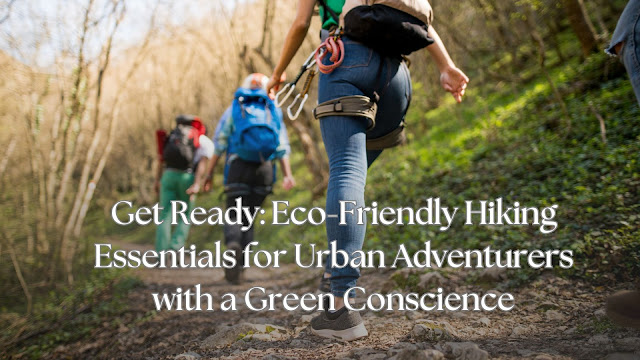I’ll be brutally honest—I’ve never understood how some people fail to grasp how easy and necessary it is to be green. How can you carry a full bottle of water into nature but suddenly be too weak to take the empty one back with you? Seriously, what is wrong with you? Maybe I owe my frustration to my father, who was relentless when it came to respecting nature. He had one simple rule: “If you step into nature, you take responsibility for it.” No excuses. No exceptions.
He taught me so many things—things that should be common sense but, unfortunately, aren’t. And if you’re someone who loves the outdoors (or even just takes the occasional walk in the park), you need to hear them too. So let me share them with you.
1. Use What You Have and Buy Only What You Need
It’s easy to fall into the trap of thinking you need the latest, most high-tech hiking gear to enjoy the great outdoors. But the truth is, hiking doesn’t require constantly upgrading your wardrobe or gear collection. Sustainable hiking starts with using what you already own and only buying new items when absolutely necessary.
Repurpose your existing gear. That old backpack or sturdy jacket you’ve had for years? Keep using it! There’s no need to replace perfectly functional equipment just because a new version is on the market.
Avoid fast-fashion outdoor wear. Outdoor brands release new collections every season, but there’s no reason to follow hiking fashion trends. A good quality jacket, pants, and boots will last for years if taken care of properly.
Buy secondhand or from sustainable brands. If you truly need to replace an item, check thrift stores, online marketplaces, or brands that use recycled and ethical materials.
By shifting your mindset away from chasing trends, you not only reduce waste but also save money while making a more meaningful impact on the environment.
2. Reusable Water Bottles and Filtration Systems
Single-use plastic is one of the biggest environmental threats, and I refuse to be part of that problem. Instead of disposable bottles, I always carry:
A stainless steel or BPA-free reusable water bottle that keeps my water cool even on hot days.
A compact water filter or purification tablets, so I can safely refill from streams without worrying about contamination.
I once ran out of water on a longer-than-expected trail, and my water filter saved me from dehydration—while also saving plastic from ending up in landfills!
3. Zero-Waste Snacks and Meals
Hiking makes me hungry, but I no longer rely on individually wrapped protein bars and plastic-heavy trail mix. Instead, I prepare my snacks with sustainability in mind:
Homemade granola bars wrapped in beeswax wraps instead of plastic.
Bulk nuts and dried fruits stored in reusable silicone bags.
A lightweight, reusable container for packing fresh fruit, sandwiches, or even a warm meal.
On one group hike, I shared my homemade trail mix in a reusable bag, and it started a whole conversation about how easy it is to avoid waste on the go!
4. Leave No Trace (Literally)
One of the simplest yet most impactful ways to hike sustainably is by following the Leave No Trace (LNT) principles. I live by these rules every time I hit the trail:
Pack it in, pack it out. Every bit of trash—even biodegradable ones like fruit peels—goes back with me.
Stay on marked trails. This prevents erosion and protects delicate ecosystems.
Respect wildlife. I keep my distance, avoid feeding animals, and take only photos.
5. Eco-Friendly Sunscreen and Bug Spray
It took me a while to realize that traditional sunscreens and bug sprays contain harmful chemicals that can damage water sources and harm wildlife. Now, I opt for:
Reef-safe sunscreen, which protects both my skin and aquatic ecosystems.
Natural bug repellent made with essential oils like citronella and eucalyptus.
I once swam in a crystal-clear lake after applying chemical-heavy sunscreen, only to notice a strange film on the water’s surface. Since switching to eco-friendly options, I’ve never had to worry about polluting natural water sources again.
6. Sustainable Navigation and Tech Use
Relying on tech in the wilderness can be tricky, but when I do, I make sure it’s sustainable:
Solar-powered chargers keep my phone and GPS running without needing disposable batteries.
Offline maps and a good old-fashioned compass prevent unnecessary printing of paper maps.
7. Support Local and Sustainable Trail Organizations
One of the most fulfilling parts of being an eco-conscious hiker is giving back. I try to:
Join local trail clean-ups and conservation efforts.
Support national parks and hiking organizations that promote sustainability.
Educate fellow hikers on responsible outdoor practices.
Final Thoughts: Hiking Sustainably is a Journey
Going green on the trail doesn’t happen overnight—it’s a process of small, mindful changes. Over the years, I’ve realized that every choice I make, from the gear I buy to the snacks I pack, contributes to the health of the places I love to explore.
So, are you ready to gear up and go green? Let’s hit the trails with purpose and leave nothing but footprints behind! 🌿🥾

Comments
Post a Comment